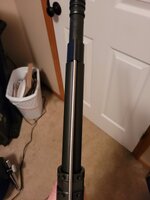- Messages
- 736
- Reactions
- 1,503
This doesn't surprise me, but wouldn't you rather go into a fight with something that works EVERY time . . . Actually sometimes the issue is simply a lubrication problem. I encountered that when shooting 220 gr. sub loads in my 7.5".
Anyway, as I've set up my 300 BLK Mk18 Mod 1, the pistol length gas system is 'mo betta fo you'.

Anyway, as I've set up my 300 BLK Mk18 Mod 1, the pistol length gas system is 'mo betta fo you'.


















